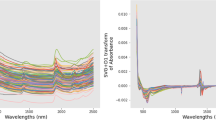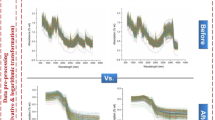Abstract
This study is focused on evaluating the potential of deep neural networks for assessing soil properties based on VIS–NIR spectroscopy with spectral wavelength ranges of 350–2500 nm and 10 nm resolution on a global scale. The dataset was provided by the ICRAF-ISRIC soil spectral library and consists of 4438 samples from 58 countries. In This research we used the powerful one-dimensional (1D) convolutional neural network (CNN) models to predict soil organic carbon (OC), pH, calcium carbonate (CaCO3), cation exchange capacity (CEC), effective CEC (ECEC), sum of cations (SC), base saturation (BS), exchangeable acidity (ACe), exchangeable cations (aluminum (Al), calcium (Ca), magnesium (Mg), sodium (Na) and potassium (K)), silt, sand and clay content. Also, traditional regression approaches of spectral data including partial least squares regression (PLSR), multilayer perceptron (MLP) and random forest (RF) with optimum preprocessing of spectral data were also tested and the models’ performances were evaluated and compared. The optimum structure of models was determined by testing different components for PLSR, selecting the best number of neurons in the hidden layer, activation functions, and solvers for MLP, and finding the proper number of trees and maximum depth in RF. The CNN-based model estimated the OC, pH, CaCO3, CEC, ECEC, SC, BS, ACe, Al, Ca, Mg, Na, K, silt, sand and clay content with the ratio of percent deviation (RPD) of 2.98, 1.9, 2.48, 2.01, 2.05, 2.39, 1.97, 1.01, 1.59, 2.06, 1.72, 1.69, 1.29, 1.38, 1.8 and 1.97, respectively. We evaluated the performance of CNN-based methods with an effective architecture for soil spectral data analysis. The CNN model outperforms other regression algorithms in terms of accuracy and low predicting errors using non-preprocessed data. However, the use of diverse soil properties for modeling spectral data can provide sufficient information on the advantages and disadvantages of VIS–NIR data in predictions.






Similar content being viewed by others
Data availability
The datasets generated during and/or analyzed during the current study are available in the International Soil Reference and Information Centre (ISRIC) repository, (https://data.isric.org/geonetwork/srv/api/records/1081ac75-78f7-4db3-b8cc-23b78a3aa769).
Abbreviations
- X:
-
Current batch
- μ :
-
Mean
- σ :
-
Standard deviation
- γ, β, ∈ :
-
Constant parameters
- Oi:
-
Measured value
- n:
-
Number of samples
- Pi:
-
Predicted value
- SD:
-
Standard deviation
- R2:
-
Coefficient of determination
- RMSE:
-
Root-mean-square error
- MAE:
-
Mean absolute error
- RPD:
-
Ratio of percent deviation
References
Bai Z, Chen S, Hong Y et al (2023) Estimation of soil inorganic carbon with visible near-infrared spectroscopy coupling of variable selection and deep learning in arid region of China. Geoderma 437:116589. https://doi.org/10.1016/j.geoderma.2023.116589
Baumgardner MF, Silva LF, Biehl LL, Stonery ER (1985) Reflectance properties of soils. Adv Agron 38:1–44. https://doi.org/10.1016/S0065-2113(08)60672-0
Castaldi F, Palombo A, Santini F et al (2016) Evaluation of the potential of the current and forthcoming multispectral and hyperspectral imagers to estimate soil texture and organic carbon. Remote Sens Environ 179:54–65. https://doi.org/10.1016/j.rse.2016.03.025
Chang C, Laird D, Mausbach MJ, Hurburgh CR (2001) Analyses of soil properties. Soil Sci Soc Am J 65:480–490. https://doi.org/10.2136/sssaj2001.652480x
Demattê JAM, Ramirez-Lopez L, Marques KPP, Rodella AA (2017) Chemometric soil analysis on the determination of specific bands for the detection of magnesium and potassium by spectroscopy. Geoderma 288:8–22. https://doi.org/10.1016/j.geoderma.2016.11.013
Garrity D, Bindraban P (2004) A globally distributed soil spectral library visible near infrared diffuse reflectance spectra. ICRAF (World Agrofor Centre)/ISRIC (World Soil Information) Spectr Libr Nairobi, Kenya
Gholizadeh A, Borůvka L, Saberioon MM et al (2015) Comparing different data preprocessing methods for monitoring soil heavy metals based on soil spectral features. Soil Water Res 10:218–227. https://doi.org/10.17221/113/2015-SWR
Gholizadeh A, Žižala D, Saberioon M, Borůvka L (2018) Soil organic carbon and texture retrieving and mapping using proximal, airborne and Sentinel-2 spectral imaging. Remote Sens Environ 218:89–103. https://doi.org/10.1016/j.rse.2018.09.015
Griffiths PR, Dahm DJ (2007) Continuum and discontinuum theories of diffuse reflection. Handbook of near-infrared analysis. CRC Press, Boca Raton, FL, pp 39–82
Guerrero A, De Neve S, Mouazen AM (2021) Current sensor technologies for in situ and on-line measurement of soil nitrogen for variable rate fertilization: A review, 1st edn. Elsevier Inc
Hosseinpour-Zarnaq M, Omid M, Sarmadian F, Ghasemi-Mobtaker H (2023) A CNN model for predicting soil properties using VIS–NIR spectral data. Environ Earth Sci 82:382. https://doi.org/10.1007/s12665-023-11073-0
Islam K, Singh B, McBratney A (2003) Simultaneous estimation of several soil properties by ultra-violet, visible, and near-infrared reflectance spectroscopy. Soil Res 41:1101–1114. https://doi.org/10.1071/SR02137
Jia S, Li H, Wu X, Li Q (2019) Laboratory-based hyperspectral image analysis for the classification of soil texture. J Appl Remote Sens 13:46508
Kuang B, Mouazen AM (2012) Influence of the number of samples on prediction error of visible and near infrared spectroscopy of selected soil properties at the farm scale. Eur J Soil Sci 63:421–429. https://doi.org/10.1111/j.1365-2389.2012.01456.x
Kuang B, Tekin Y, Mouazen AM (2015) Comparison between artificial neural network and partial least squares for on-line visible and near infrared spectroscopy measurement of soil organic carbon, pH and clay content. Soil Tillage Res 146:243–252. https://doi.org/10.1016/j.still.2014.11.002
Morellos A, Pantazi X, Moshou D et al (2016) Machine learning based prediction of soil total nitrogen, organic carbon and moisture content by using VIS-NIR spectroscopy. Biosyst Eng 152:104–116. https://doi.org/10.1016/j.biosystemseng.2016.04.018
Naimi S, Ayoubi S, Di Raimo LADL, Dematte JAM (2022) Quantification of some intrinsic soil properties using proximal sensing in arid lands: Application of Vis-NIR, MIR, and pXRF spectroscopy. Geoderma Reg 28:e00484. https://doi.org/10.1016/j.geodrs.2022.e00484
Ng W, Minasny B, de Sousa MW, Melo Demattê JA (2020) The influence of training sample size on the accuracy of deep learning models for the prediction of soil properties with near-infrared spectroscopy data. Soil 6:565–578. https://doi.org/10.5194/soil-6-565-2020
Padarian J, Minasny B, McBratney AB (2018) Using deep learning to predict soil properties from regional spectral data. Geoderma Reg 15:e00198. https://doi.org/10.1016/j.geodrs.2018.e00198
Pavia DL, Lampman GM, Kriz GS, Vyvyan JA (2014) Introduction to spectroscopy. Cengage learning
Pinheiro ÉFM, Ceddia MB, Clingensmith CM et al (2017) Prediction of soil physical and chemical properties by visible and near-infrared diffuse reflectance spectroscopy in the Central Amazon. Remote Sens 9:1–22. https://doi.org/10.3390/rs9040293
Ramirez-Lopez L, Schmidt K, Behrens T et al (2014) Sampling optimal calibration sets in soil infrared spectroscopy. Geoderma 226:140–150
Sharififar A, Singh K, Jones E et al (2019) Evaluating a low-cost portable NIR spectrometer for the prediction of soil organic and total carbon using different calibration models. Soil Use Manag 35:607–616. https://doi.org/10.1111/sum.12537
Simonyan K, Zisserman A (2014) Very deep convolutional networks for large-scale image recognition. arXiv Prepr arXiv14091556. https://doi.org/10.48550/arXiv.1409.1556
Singh S, Kasana SS (2019) Estimation of soil properties from the EU spectral library using long short-term memory networks. Geoderma Reg 18:e00233. https://doi.org/10.1016/j.geodrs.2019.e00233
Sorenson PT, Small C, Tappert MC et al (2017) Monitoring organic carbon, total nitrogen, and pH for reclaimed soils using field reflectance spectroscopy. Can J Soil Sci 97:241–248. https://doi.org/10.1139/cjss-2016-0116
Srivastava N, Hinton G, Krizhevsky A et al (2014) Dropout: A simple way to prevent neural networks from overfitting. J Mach Learn Res 15:1929–1958
Stenberg B (2010) Effects of soil sample pretreatments and standardised rewetting as interacted with sand classes on Vis-NIR predictions of clay and soil organic carbon. Geoderma 158:15–22. https://doi.org/10.1016/j.geoderma.2010.04.008
Stenberg B, Viscarra Rossel RA, Mouazen AM, Wetterlind J (2010) Visible and near infrared spectroscopy in soil science. Adv Agron 107:163–215. https://doi.org/10.1016/S0065-2113(10)07005-7
van Reeuwijk L. (2002) Procedures for soil analysis. Procedures for soil analysis International Soil Reference and Information Centre (ISRIC)
Viscarra Rossel RA, Behrens T, Ben-Dor E et al (2016) A global spectral library to characterize the world’s soil. Earth-Sci Rev 155:198–230. https://doi.org/10.1016/j.earscirev.2016.01.012
Xu D, Ma W, Chen S et al (2018) Assessment of important soil properties related to Chinese Soil Taxonomy based on vis–NIR reflectance spectroscopy. Comput Electron Agric 144:1–8. https://doi.org/10.1016/j.compag.2017.11.029
Xu D, Zhao R, Li S et al (2019) Multi-sensor fusion for the determination of several soil properties in the Yangtze River Delta, China. Eur J Soil Sci 70:162–173
Yang J, Wang X, Wang R, Wang H (2020) Combination of convolutional neural networks and recurrent neural networks for predicting soil properties using Vis–NIR spectroscopy. Geoderma 380:114616. https://doi.org/10.1016/j.geoderma.2020.114616
Zhao D, Arshad M, Li N, Triantafilis J (2021a) Predicting soil physical and chemical properties using vis-NIR in Australian cotton areas. CATENA 196:104938. https://doi.org/10.1016/j.catena.2020.104938
Zhao D, Arshad M, Wang J, Triantafilis J (2021b) Soil exchangeable cations estimation using Vis-NIR spectroscopy in different depths: Effects of multiple calibration models and spiking. Comput Electron Agric 182:105990. https://doi.org/10.1016/j.compag.2021.105990
Zhong L, Guo X, Xu Z, Ding M (2021) Soil properties : Their prediction and feature extraction from the LUCAS spectral library using deep convolutional neural networks. Geoderma 402:115366. https://doi.org/10.1016/j.geoderma.2021.115366
Acknowledgements
The topsoil dataset used in this work was made available by ISRIC-World Soil Information is duly acknowledged.
Funding
No funding was received for conducting this study.
Author information
Authors and Affiliations
Contributions
Mehdi Safaie, Mohammad Hosseinpour-Zarnaq, Mahmoud Omid, Fereydoon Sarmadian and Hassan Ghasemi-Mobtaker wrote the main manuscript text. Mohammad Hosseinpour-Zarnaq designed the manuscript idea and developed the codes. Mehdi Safaie and Mohammad Hosseinpour-Zarnaq executed the codes. All authors analyzed and validated the results. All authors read and approved the final manuscript.
Corresponding authors
Ethics declarations
Competing interests
The authors declare no competing interests.
Conflict of interest
The authors declare no competing interests.
Additional information
Communicated by: H. Babaie
Publisher's Note
Springer Nature remains neutral with regard to jurisdictional claims in published maps and institutional affiliations.
Rights and permissions
Springer Nature or its licensor (e.g. a society or other partner) holds exclusive rights to this article under a publishing agreement with the author(s) or other rightsholder(s); author self-archiving of the accepted manuscript version of this article is solely governed by the terms of such publishing agreement and applicable law.
About this article
Cite this article
Safaie, M., Hosseinpour-Zarnaq, M., Omid, M. et al. Using deep neural networks for evaluation of soil quality based on VIS–NIR spectroscopy. Earth Sci Inform 17, 271–281 (2024). https://doi.org/10.1007/s12145-023-01168-4
Received:
Accepted:
Published:
Issue Date:
DOI: https://doi.org/10.1007/s12145-023-01168-4




